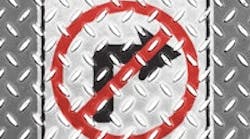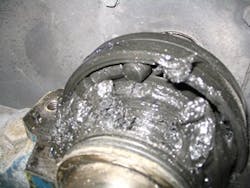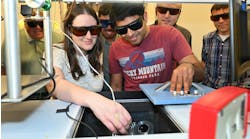Vibration-based condition monitoring can provide crucial insights about a process plant's rotating machines. Indeed, analysis of vibration data can pinpoint a number of common malfunctions and problems.
Rotors usually are the principal source of vibrations. These vibrations eventually are transmitted to the machine's pedestals, casing and foundation. So, measuring vibrations at their actual source is vital for correct evaluation of equipment health. That's why the generally accepted practice is to utilize two non-contacting displacement transducers installed in an orthogonal XY configuration (usually +45° and -45° from vertical) on or near each radial bearing. Vibration measurements on a machine's casing from velocity pickups or accelerometers just provide indirect information about the vibration source. In addition, it's extremely useful to install axially oriented non-contacting proximity transducers for the rotor assemblies.
UNBALANCE
This is the most common malfunction in chemical processing rotating machines. It stems from unequal mass distribution at each section of the rotating assembly. In an unbalanced condition, the rotor's mass centerline doesn't coincide with the axis of rotation. The unbalance represents the first fundamental mechanism to transfer rotational energy into vibration. The unbalance vibration speed equals the rotor assembly rotating speed. The unbalance vibration is a typical sinusoidal waveform. The rotor response depends on both the rotor combined dynamic stiffness (i.e., the effects of stiffness and damping) and the unbalance excitation. Therefore, any changes in the rotor-dynamic response may result from either a change in unbalance or a change in the restraining rotor-dynamic stiffness components (e.g., a shaft crack can reduce rotor stiffness).
MISALIGNMENT
The second most common malfunction is a rotor getting out of alignment. This causes a constant radial force that pushes the rotor assembly to a side. The same result can occur from a strong radial component of the fluid flow in the rotating machine.
Because of the radial force, the rotor gets displaced from its original position, increasing rotational eccentricity; this is particularly problematic at bearings and seals. The rotor assembly also may become bowed and rotate in a bow configuration. These conditions lead to nonlinear effects, adding higher-order harmonics of vibration components (particularly second-order (2×) harmonics) to the rotor's synchronous component (1×) response. The appearance of 2× harmonics with comparable vibration amplitude to the first harmonic is a good indication of an alignment issue.
Axial measurements additionally may indicate an impending excessive radial load or misalignment problem on a rotating machine.
Continuously acting radial load causes reversal stresses in the rotor. For a high-speed continuously operating machine, the number of the stress reversal cycles may swiftly reach the fatigue limit — and thus prompt rotor cracking and premature failure.
ROTOR RUBBING
Contact between the rotor and the stationary part of a rotating machine is a serious malfunction that could lead to a catastrophic failure. Rubbing usually occurs as a secondary effect of a primary malfunction, such as unbalance, misalignment, fluid-induced dynamic effects or self-excited vibrations. Rub-related failures occur quite often in chemical processing equipment.
A light partial rub at a high rotating speed usually results in fractional sub-synchronous vibrations, along with the synchronous vibration (1×). In a machine with a relatively low rotating speed, the rotor bounces inside the contact point, producing multiple high harmonics in addition to 1×.
High radial (normal) and corresponding frictional (tangential) forces at the contacting surfaces during a rotor rub could lead to extremely severe damage of the seal and rotor surfaces in a very short time. In addition, the rotor operates under severe alternating stress with relatively high frequency.
Rotor-to-stationary-element rubbing actually is a very harmonic-rich vibration phenomenon, resulting in rapidly changing system parameters with a tendency for chaotic motions. The diagnosis of rotor rubbing from vibration data is based on the appearance of: 1) sub-synchronous fractional components (particularly ½×); 2) relatively high harmonics (2× and 3×); and 3) changes in shaft centerline position.
FLUID-INDUCED INSTABILITIES
Rotating shafts generally operate in a fluid environment. An interaction between the rotor and the surrounding fluid becomes significant if the clearances between rotating and stationary parts are small and rotation is eccentric. Because of friction between fluid and machine components, the shaft rotation generates a circumferential fluid flow. This, in turn, produces a dynamic effect on the rotating machine parts. Such situations occur in lightly loaded fluid-lubricated bearings, seals, balance pistons, stator/blade tip clearances, rotor/stator peripheries, and rotors filled with fluids such as those in centrifugal pumps and compressors. Dynamic effects of rotor/fluid interaction are known as "fluid whirl" or "fluid whip" rotor self-excited vibrations.
The whirl frequency is generated purely by the fluid interaction and is related to the fluid film radial damping. The fluid involved in the circumferential motion transfers energy from rotation to lateral vibration. For well-balanced rotors, the whirl vibrations are quite persistent. At the beginning of a fluid whirl, the rotor vibrates as a rigid body.
When the rotating speed approaches the transfer speed (i.e., rotating speed×first critical speed/whirl speed), the rotor self-excited whirl vibrations get smoothly transformed into fluid whip, with a frequency asymptotically approaching the rotor high-eccentricity first critical frequency (i.e., the first critical frequency slightly modified by high-eccentricity nonlinearities). The fluid whip is usually persistent. At certain rotating speeds, however, it may disappear and then reappear again. Instabilities may cease and recur.
The main cause of the whirl/whip vibrations is the fully developed circumferential fluid flow. Reducing the circumferential-flow-related tangential force strength will make the rotor more stable. This may be accomplished either by moving the shaft to the higher eccentricities by applying a "friendly" external radial load force to the rotor, or by modifying the fluid flow pattern. Appropriately loaded noncircular bearings, bearings with lobes and grooves, and, particularly, bearings with tilting pads fulfill both objectives. Nowadays, tilting-pad bearings are very common in high-speed rotating machines. Seals with swirl brakes and anti-swirl injections achieve the goal of circumferential flow reduction, resulting in stable rotor operation. The shaft rotation at a higher eccentricity not only can reduce circumferential velocity ratio, but also may raise the fluid film's radial damping and stiffness, which are beneficial for shaft stability. Increasing the fluid pressure also can provide greater fluid radial stiffness. Some reports indicate externally pressurized bearings offer good stability features, but others point to operational problems and dynamic issues for some pressurized bearings. So, approach the use of such bearings with great care.
Diagnosing fluid whirl/whip vibrations may be relatively easy, particularly when transient startup or shutdown vibration data are available. However, identifying the actual cause of the instability is more difficult, especially when only the whip vibrations are present.
Because of the bearing/fluid interactions, the fluid whirl vibrations have frequencies slightly lower than ½× (for most bearings, whirl speeds usually range from 0.38 to 0.47 of the rotor speed). The fluid seal or stator/blade tip whirl vibrations may exhibit quite different vibration behavior and frequencies. This is especially true when the seals are equipped with swirl brakes or anti-swirl injections as well as when there's a significant level of fluid recirculation, as often happens in process pumps and compressors. The whirl vibrations even may exhibit frequencies higher than the rotating frequency (1×).
LOOSE PART
Looseness between the rotor supporting pedestal and the foundation (for example, due to a loose bolt) is a common malfunction. The unbalanced force carried by the rotor occasionally may exceed the gravity force (or other forces) applied to the machine. This can cause a periodic lifting of the pedestal, resulting in a reduction in system stiffness, its cyclic variability and impacting. As a result, the rotor may exhibit changes in synchronous responses, and fractional sub-synchronous vibrations (most commonly ½×) may appear. The diagnosis of pedestal looseness (particularly foundation bolt looseness) usually is based on the appearance of ½× vibrations and visual inspection of the bearing, pedestal and foundation fastenings.
Looseness in rotating elements such as disks or thrust collars mounted on rotating shafts (or bearings untightened in bearing pedestals) represents another type of malfunction. A disconnected disk or a thrust collar still may rotate but at a different speed than that of the machine's shaft. A loose bearing may start rotating (dragged into motion by the rotating shaft) or may stop suddenly. The clearances, friction conditions between the shaft and the loose part, and the tangential external force applied to the part (such as the external fluid dynamic drag) play important roles in the rotor-dynamic response. A loose rotating part usually carries an unbalance that changes the balance state of the rotating machine. This results in a modification of the synchronous vibrations (1×) and also appearance of the loose-part unbalance-related vibration components.
The loose part rotating frequency usually is a function of the shaft/loose part clearance, the surface friction, and the tangential drag coefficient. Depending on the particular machine, the latter can make the loose part spin faster or slower than the rotor rotating frequency. In both situations, friction and fluid drag act in opposite directions. At steady-state conditions, the two may balance each other, giving a constant loose-part rotating frequency. If loose part speed doesn't differ very much from the rotor rotating speed, the resulting vibrations exhibit the characteristic pattern of a beat. Most often, however, the looseness of a rotating part leads to transient conditions.
BEARING PROBLEMS
Hydrodynamic and rolling-element bearings used in rotating machines feature a small bearing clearance that's appropriate for normal operation of the rotor. Poorly lubricated or worn bearing surfaces inevitably increase the clearance — and thus decrease system stiffness. Excessive bearing clearance can cause variable bearing-system stiffness, thereby providing nonlinear conditions for unbalance-related excitation that may lead to rotor instability.
The physical phenomena occurring in the worn (or oversize) bearing system resemble a mirror image of those during rotor-to-stator rubbing. In rubbing, during a cycle of vibration the system becomes periodically stiffer, which can lead to an increase in the average stiffness. In the worn (or oversize) bearing system, the average stiffness decreases. The rubbing occurrences are described as "normal-tight" situations, while the worn (oversize) bearing is "normal-loose." In both situations, two other physical phenomena, namely friction and impacting, are involved. However, their role and strength differ in each specific case. Distinguishing a worn (or oversize) bearing malfunction from rubbing requires careful study of the recorded vibration of the rotor.
During rubbing, there's a high rotor lateral excursion from the rubbing spot and, therefore, more impacting; unsteady transient motion occurs. Within a worn (or oversize) bearing, the journal remains close to the bearing surface, even when the contact is broken. The consecutive contacts don't produce relatively high power impacts. There are far fewer transient components and weaker high harmonics in the vibration spectrum of a worn bearing compared to the rub cases.
SUCCESS STORIES
Let's now look at three process-plant case studies that show the value of vibration data in diagnosing malfunctions.
One site relies on a large, ≈14-MW, ≈3,600-rpm compressor. Vibration values (peak-to-peak) of 36 µ, 5 µ and 12 µ were observed at 1×, 1.5×, and 2×, respectively. There also was considerable ½× sub-synchronous vibration (31µ, peak-to-peak). Detailed study of the vibration data showed the strong ½× sub-synchronous vibration came from light rubbing of the rotating assembly of this compressor train. Inspection of the machine confirmed this rubbing.
Another plant was concerned about a compressor train with an electric-motor-driven rotor supported by oil-lubricated bearings that ran at ≈6,000 rpm. Observed main vibration elements (peak-to-peak) were ≈41 µ at ≈0.4× of the rotating speed and ≈34 µ at 1×. The high ≈0.4× value indicated a bearing whirl problem. So, the plant installed modern tilting-pad bearings in the compressor train to solve the problem.
The third facility operates a medium-size, 11-MW, ≈4,000-rpm compressor train. Recorded main vibration amplitude components (peak-to-peak) were 41µ at ⅓×, 47µ at ½×, 52µ at 1×, 15 µ at 1.5×, 16µ at 1× and 13 µ at 2×. The ½× and ⅓× sub-synchronous vibrations, plus the rich spectrum of higher harmonics (particularly 2×), pointed to a loose pedestal connection. A careful site inspection showed loose foundation bolts. The plant repaired the foundation and regrouted the train.
AMIN ALMASI is lead rotating equipment engineer at WorleyParsons Services Pty. Ltd., Brisbane, Australia. E-mail him at [email protected].



